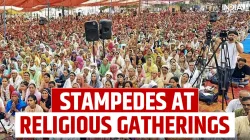Hathras stampede kills over 120: Why are religious gatherings in India prone to such tragedies? EXPLAINED
Stampedes at religious gatherings in India are unfortunately not uncommon occurrences. These incidents usually happen during large congregations, pilgrimages or festivals where huge crowds gather in relatively confined spaces.

Hathras Stampede: The deadly stampede in Uttar Pradesh's Hathras on Tuesday, which claimed over 120?fatalities, occurred at a congregation led by Baba Narayan Hari, also known as 'Bhole Baba.' Once a government official, Baba Narayan Hari turned into a religious preacher two decades ago and amassed a large following in the state. The disaster unfolded as people were leaving a 'satsang' in Phulrai village, where devotees tragically suffocated, causing bodies to pile up in one of the worst such tragedies in recent years.?The stampede occurred during the satsang' (prayer meeting) which was attended by thousands. The event, which was privately organized, had received permission from the Sub-Divisional Magistrate (SDM). Uttar Pradesh Chief Secretary Manoj Kumar Singh on Tuesday said overcrowding was one of the reasons behind the deadly incident.?
This tragic incident is not unprecedented, as stampedes at temples and religious gatherings in India have claimed many lives over the years. Notable among these are the stampede at Maharashtra's Mandhardevi temple in 2005, which resulted in the deaths of more than 340 devotees, and the 2008 tragedy at Rajasthan's Chamunda Devi temple, where at least 250 people were killed.?Another stampede at a religious gathering at Naina Devi temple in Himachal Pradesh caused the loss of lives of 162 people in 2008.
Religious gatherings prone to deadly stampedes
Stampedes can be triggered by various factors, including rumours that incite panic, poor management, and overcrowding. Despite their deadly outcomes, mass stampedes at religious gatherings are unfortunately not rare in India. A 2013 study published in the 'International Journal of Disaster Risk Reduction' revealed that 79 per cent of stampedes in India occur during religious gatherings and pilgrimages. The risk of stampedes is heightened by the location of many major temples on hills, riverbanks, or other uneven terrains. Additionally, the tradition of large religious gatherings in rural areas often sees thousands of devotees converging in cramped spaces lacking basic facilities, including adequate entry and exit points for emergencies.
The role of authorities in managing large crowds is crucial and their failures cannot be overlooked. Despite the National Disaster Management Authority (NDMA) releasing guidelines for crowd management in 2014, such tragic incidents continue to occur. Active implementation of crowd control measures is essential to prevent these disasters. Ensuring separate entry and exit points, deploying adequate police and security personnel, and using a public address system to dispel rumours are all important steps that can help avoid stampedes and save many lives.
What is a stampede??
A stampede is a sudden, uncontrolled rush of a large group of people, often driven by panic or fear. These incidents can occur in various settings, such as religious gatherings, concerts, sports events, or other crowded places. Stampedes are typically triggered by factors like rumours, perceived threats, poor crowd management, or overcrowded conditions, and they can lead to serious injuries or fatalities due to trampling, suffocation, or crushing. Proper crowd control measures and emergency planning are crucial to prevent and manage such situations.
ALSO READ:?Hathras accident: Stampede during satsang in UP, women, children among 116 dead
?